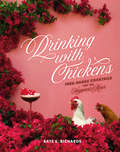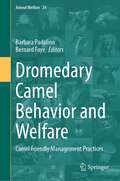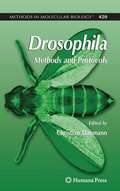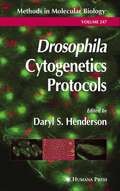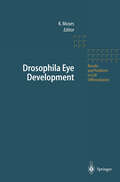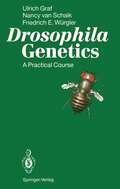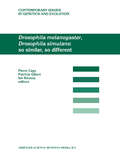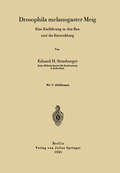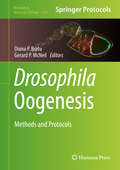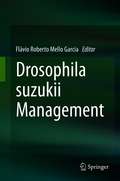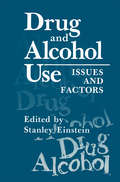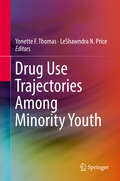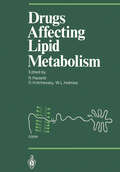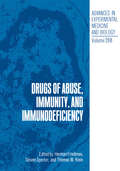- Table View
- List View
Drinking with Chickens: Free-Range Cocktails for the Happiest Hour
by Kate E. RichardsIt's drinks, it's chickens: It's the cocktail book you didn't know you needed!To add some extra happy to your happy hour , invite a chicken and pour yourself a drink. Author Kate Richards serves up cocktails made for Instagram with the spoils of her Southern California garden, chicken friends by her side. Enjoy any (or all) of the 60+ deliciously drinkable garden-to-glass beverages, such as:Lilac Apricot Rum Sour Meyer Lemon + Rosemary Old Fashioned Rhubarb Rose Cobbler Blackberry Sage Spritz Cantaloupe Mint Rum PunchCocktails are arranged seasonally, and are 100% accessible for those of us without perpetually sunny backyard gardens at our disposal. Drinking with Chickens will quickly become a boozy favorite, perfect for gifting or for hoarding all for yourself. You don't need chickens to enjoy these drinks or the colorful photos, but be careful, because you may even find yourself aspiring to be, as Kate is, a home chixologist overrun by gorgeous, loud, early-rising egg-laying ladies, and in need of a very strong drink.
Drinking with My Dog: The Canine Lover's Cocktail Book
by Natalie BovisBestselling author, award-winning mixologist, and passionate animal advocate Natalie Bovis pairs fascinating doggie trivia with easy-to-make drink recipes in this unique cocktail book for dog lovers.If there's one thing we know, it's that we can survive anything with a furry companion and a cocktail by our side. Enter Drinking with My Dog, which combines our devotion to dogs with celebratory drinks in this charming, pet-centric cocktail book from Natalie Bovis of The Liquid Muse. Inside you&’ll find everything you need to know to set up your home bar and mix 60+ delicious cocktails organized into dog-themed chapters, featuring rescue dogs, famous furbabies, wild dogs, cocktails for pawlidays throughout the year, and more. Also included is canine history, whimsical illustrations, and toast-worthy quotes. Drinking with My Dog is the ideal companion for dog lovers and drink enthusiasts alike, and is the cocktail book we&’ve always needed to help us raise a glass to wo/man&’s best friend!
Dromedary Camel Behavior and Welfare: Camel Friendly Management Practices (Animal Welfare #24)
by Barbara Padalino Bernard FayeThis volume gives a comprehensive review on dromedary camel handling and management by respecting its welfare, which is a global first. Beyond that, it provides a new welfare assessment tool.Expert authors lay the groundwork for understanding the animals by covering domestication, camels´ behavioral repertoire and needs, as well as dromedary camel genetics and coping with production systems. Then, the reader is equipped with the latest expertise on good management practices in camel farms, including transport, feeding, housing from racing to dairy systems, and health and hygiene. Moreover, the impact of innovative reproduction techniques and, finally, slaughter are taken into account.Camels, long confined to desert areas and kept extensively, have recently faced changes in husbandry systems and their environment. Intensification and specialization for milk, meat or sport purpose, as well as new geographic conditions have had significant impact on camel welfare.This book is a must-read for all camel industry members, breeders, veterinarians, and researchers, who want to practice camel breeding and management while safeguarding the behavioral needs and welfare of these amazing animals.
Drosophila: Methods and Protocols (Methods in Molecular Biology #420)
by Christian DahmannDrosophila is a comprehensive collection of methods and protocols for Drosophila, one of the oldest and most commonly used model organisms in modern biology. The protocols are written by the scientists who invented the methods. The text presents a diverse set of techniques that range from the basic handling of flies to more complex applications. This is the perfect reference manual for Drosophila researchers.
Drosophila Cytogenetics Protocols (Methods in Molecular Biology #247)
by Daryl S. HendersonLeading drosophilists describe in step-by-step detail all the essential techniques for studying Drosophila chromosomes and suggest new avenues for scientific exploration. The chapters emphasize specimen preparation (from dissection to mounting) and cover both polytene and mitotic/meiotic chromosomes in depth. Each fully tested and readily reproducible protocol offers a background introduction, equipment and reagent lists, and tips on troubleshooting and avoiding pitfalls. A cutting-edge FISH and immunolocalization technique will be important for discovering how DNA sequence influences higher-order chromosome architecture and ultimately gene expression.
Drosophila Eye Development (Results and Problems in Cell Differentiation #37)
by KevinMoses1 Kevin Moses It is now 25 years since the study of the development of the compound eye in Drosophila really began with a classic paper (Ready et al. 1976). In 1864, August Weismann published a monograph on the development of Diptera and included some beautiful drawings of the developing imaginal discs (Weismann 1864). One of these is the first description of the third instar eye disc in which Weismann drew a vertical line separating a posterior domain that included a regular pattern of clustered cells from an anterior domain without such a pattern. Weismann suggested that these clusters were the precursors of the adult ommatidia and that the line marks the anterior edge of the eye. In his first suggestion he was absolutely correct - in his second he was wrong. The vertical line shown was not the anterior edge of the eye, but the anterior edge of a moving wave of patterning and cell type specification that 112 years later (1976) Ready, Hansen and Benzer would name the "morphogenetic furrow". While it is too late to hear from August Weismann, it is a particular pleasure to be able to include a chapter in this Volume from the first author of that 1976 paper: Don Ready! These past 25 years have seen an astonishing explosion in the study of the fly eye (see Fig.
Drosophila Genetics: A Practical Course
by Ulrich Graf Nancy van Schaik Friedrich E. WürglerThe Biological Sciences are in the midst of a scientific rev olution. During the past decade under the rubric of molecu lar biology, chemistry and physics have assumed an integral role in biological research. This is especially true in ge netics, where the cloning of genes and the manipulation of genomic DNA have become in many organisms routine laboratory procedures. These noteworthy advances, it must be empha sized, especially in molecular genetics, are not autonomous. Rather, they have been accomplished with those organisms whose formal genetics has been documented in great detail. For the beginning student or the established investigator who is interested in pursuing eukaryote molecular genetic re search, Drosophila melanogaster, with its rich body of formal genetic information is one organism of choice. The book "Drosophila Genetics. A Practical Course" is an indispens able source of information for the beginner in the biology and formal genetics of Drosophila melanogaster. The scope of this guide, a revision and enlargement of the original German language version, is broad and instructive. The information included ranges from the simple, but necessary, details on how to culture and manipulate Drosophila flies to a series of more sophisticated genetic experiments. After completing the experiments detailed in the text, all students - neophyte or experienced - will be richly rewarded by having acquired a broad base of classical genetics information relevant for the biologist in its own right and prerequisite to Drosophila genetics research - formal and/or molecular. Davis, California, Melvin M.
Drosophila melanogaster, Drosophila simulans: So Similar, So Different (Contemporary Issues in Genetics and Evolution #11)
by Pierre Capy Patricia Gibert Ian BoussyDrosophila melanogaster Meig: Eine Einführung in den Bau und die Entwicklung
by Eduard H. StrasburgerDieser Buchtitel ist Teil des Digitalisierungsprojekts Springer Book Archives mit Publikationen, die seit den Anfängen des Verlags von 1842 erschienen sind. Der Verlag stellt mit diesem Archiv Quellen für die historische wie auch die disziplingeschichtliche Forschung zur Verfügung, die jeweils im historischen Kontext betrachtet werden müssen. Dieser Titel erschien in der Zeit vor 1945 und wird daher in seiner zeittypischen politisch-ideologischen Ausrichtung vom Verlag nicht beworben.
Drosophila Oogenesis: Methods and Protocols (Methods in Molecular Biology #1328)
by Diana P. Bratu and Gerard P. McNeilThis volume provides current up-to-date protocols for preparing the ovary for various imaging techniques, genetic protocols for generating mutant clones, mosaic analysis and assessing cell death. Chapters address methods for performing genome wide gene expression analysis and bioinformatics for studies of RNA-protein interactions. Written in the highly successful Methods in Molecular Biology series format, chapters include introductions to their respective topics, lists of the necessary materials and reagents, step-by-step, readily reproducible laboratory protocols, and tips on troubleshooting and avoiding known pitfalls.Authoritative and cutting-edge, Drosophila Oogenesis: Methods and Protocols aims to ensure successful results in the further study of this vital field.
Drosophila suzukii Management
by Flávio Roberto Mello GarciaDrosophila suzukii (Matsumura) (Diptera: Drosophilidae), the spotted wing drosophila (SWD), is the most important pest affecting berry crop production worldwide. The global fresh fruit trade, coupled with the ability of the larvae to hide inside the fruit undetected until after transportation, facilitate their distribution. SWD is native to Asia, but is increasingly found in other regions: occurrences have been recorded in the Americas and Europe, and Africa, and the insects have the potential to adapt and become established in Oceania. Gathering the experiences of leading scientists in the management of D. suzukii around the globe, the book addresses D. suzukii monitoring; biological, chemical and cultural control; sterile insect technique (SIT); integrated pest management (IPM), and other control methods. It also discusses the use of drones, GPS, biotechnology, telemetry and other technological tools to make the management of this pest more efficient and accurate. As such, it is a valuable resource for scientists, professionals and students.
Drowning in My Bedroom
by null Steve ColeThe terrifying impact of global warming on vulnerable lives is laid bare in this gripping tale of survival from internationally bestselling author Steve Cole. Gayla is trapped all alone when floodwater pours into her bedroom in a residential centre for kids with disabilities. Junjun’s makeshift shack has been washed away in the flood and he needs to find medicine for his sister, who’s sick after drinking contaminated water. At first these two young people seem to have little in common and pity each other, but as the waters continue to rise, they must work together to find a way to survive.
Drug Abuse in Adolescence: Neurobiological, Cognitive, and Psychological Issues
by Denise Micheli André Luiz Monezi Andrade Eroy Aparecida da Silva Maria Lucia Oliveira de Souza-FormigoniFocusing on two central themes--the psychobiological evolution from youth to adult and the effects of drugs on the developing central nervous system--this important reference elucidates the mechanisms of chemical dependency in adolescents. Its multidisciplinary coverage analyzes addiction across major domains of human functioning against the backdrop of hormonal, cognitive, and other changes that accompany the transition to adulthood. Chapters discuss legal as well as illicit drugs, examine age-related social contexts, and present the latest findings on links between drug use and mental disorders.Throughout, the contributors make clear that education is more valuable to understanding--and preventing--substance abuse than are prohibition and zero-tolerance thinking.Included among the topics: Cognitive development, learning, and drug use.Neurobiology of the action of drugs of abuse.Findings in adolescents with substance dependence based on neuroimaging tests.Alcohol abuse in adolescents: relevance of animal models. Effects of chronic drug abuse on the chronobiology of sleep in adolescents.Neurological and cognitive disorders arising from the chronic use of drugs of abuse.The multiple lenses for understanding its subject and the sensitivity with which causal nuances are treated make Neuroscience of Drug Abuse in Adolescence an invaluable resource for clinical and child psychologists, psychiatrists, social workers, and addiction counselors.
Drug and Alcohol Use: Issues and Factors
by Stanley EinsteinThis book is the outcome of the First International Congress on Drugs and Alcohol to be held in Israel. Both the conference and this volume grew out of the need to overcome the specious man-made barriers which continue to separate intervention plans and efforts in the broad field of substance use and misuse. This need demands that all of us become aware not only of the differences which may separate our concerns, but also of the similarities in our goals and endeavors. We are obligated to draw together toward a common effort for the common good. The conference was designed to facilitate the exploration ot generic ~ssues. This volume is designed to document a variety of factors which are basic to the defining, selection, planning, implementation, and evaluation of substance use and misuse intervention. This book is not a traditional proceedings volume. Because the needs of a listening audience are quite different from those of the solitary reader, and the roles of a workshop or plenary session participant are also dissimilar from those of the reader, not all of the Congress presentations are included, and the articles that are included have undergone major revi sions. Current intervention needs and options demand a broad spectrum of clearly defined roles for all who are or should be involved. Hence these issues, among others, served as guidelines in the preparation of the revised articles.
Drug and Gene Delivery to the Central Nervous System for Neuroprotection: Nanotechnological Advances
by Hari S. Sharma Dafin F. Muresanu Aruna SharmaThis book summarizes the latest research on drug and gene delivery to the central nervous system (CNS). The chapters address safety concerns regarding the nanotechnology that is needed to develop nanomedicine for clinical practice. Particular focus is given to new technologies that have emerged in recent years to deliver therapeutic materials, such as genes, drugs, and other agents using nanotechnologies of diverse origin. This is an ideal book for students, teachers, researchers, and clinicians interested in a deeper understanding of nanotechnological advances in therapeutic medicine. This book also: Broadens readers’ understanding of viral vector gene delivery to the brain for treating neurogenetic diseases as well as targeted gene delivery into the brain using microbubble-facilitated focused ultrasound Covers in detail the latest developments in delivering therapeutic materials, such as siRNA delivery to the brain for treating neurological diseases, neuroprotective effects of gelatin nanoparticles in stroke, and nanowired drug delivery for brain diseases, heat stroke, and CNS injury Enriches understanding of new technologies for delivering therapeutic materials treating Alzheimer’s Disease, including targeted nanodrug delivery through the blood-brain barrier and the superior neuroprotective effects of nanowired drug delivery in Alzheimer’s Disease
Drug Compounding for Veterinary Professionals
by Lauren R. Eichstadt Forsythe Alexandria E. GochenauerDrug Compounding for Veterinary Professionals Safely, effectively, and legally tailor drug treatments to the needs of your specific veterinary patients with this accessible guide Drug Compounding for Veterinary Professionals provides an accessible, easy-to-use guide to all aspects of prescribing individualized mixtures of medications in veterinary practice. Its emphasis on practical knowledge and its discussion of both in-house and external options make it a comprehensive introduction to using compounded medications in animals. It guides practitioners through every step of the process, from formulating a compound to working with outside pharmacists. The book presents guidance on how to get more information on current regulations, consider the risks and benefits, develop formulations, and more. Drug Compounding for Veterinary Professionals readers will also find: Figures and line drawings illustrating effective compounding techniques and concepts An emphasis on practical knowledge for clinical use Answers to frequently asked questions about drug compounding Drug Compounding for Veterinary Professionals is essential for any veterinary practitioner, veterinary pharmacologist, or student looking to understand this crucial component of patient care.
Drug Compounding for Veterinary Professionals
by Lauren R. Eichstadt Forsythe Alexandria E. GochenauerDrug Compounding for Veterinary Professionals Safely, effectively, and legally tailor drug treatments to the needs of your specific veterinary patients with this accessible guide Drug Compounding for Veterinary Professionals provides an accessible, easy-to-use guide to all aspects of prescribing individualized mixtures of medications in veterinary practice. Its emphasis on practical knowledge and its discussion of both in-house and external options make it a comprehensive introduction to using compounded medications in animals. It guides practitioners through every step of the process, from formulating a compound to working with outside pharmacists. The book presents guidance on how to get more information on current regulations, consider the risks and benefits, develop formulations, and more. Drug Compounding for Veterinary Professionals readers will also find: Figures and line drawings illustrating effective compounding techniques and concepts An emphasis on practical knowledge for clinical use Answers to frequently asked questions about drug compounding Drug Compounding for Veterinary Professionals is essential for any veterinary practitioner, veterinary pharmacologist, or student looking to understand this crucial component of patient care.
Drug Delivery to the Central Nervous System (Neuromethods #45)
by Kewal K. JainPlaying an important role in the treatment of neurological disorders, the delivery of drugs to central nervous system (CNS), both administered directly and administered systematically for targeted action, encounters a major challenge in the form of the blood-brain barrier (BBB), which limits the access of drugs to the brain substance. In Drug Delivery to the Central Nervous System, experts in the field present essential methods used to deliver therapeutics across the BBB, both in experimental animals and in humans. In addition to those methods, several overviews of innovative methods and their applications are presented in order to give a glimpse of the future of this research. As a volume in the successful Neuromethods series, this book presents its protocols with the kind of detailed description and implementation advice that is crucial for getting optimal results. Authoritative and cutting-edge, Drug Delivery to the Central Nervous System serves as an ideal guide to scientists continuing to pursue knowledge of the delicate interactions between pharmaceuticals and the brain.
Drug Therapy for Infectious Diseases of the Dog and Cat
by Valerie J. WiebeDrug Therapy for Infectious Diseases of the Dog and Cat provides fast access to all the information needed to effectively and responsibly treat infectious disease in dogs and cats, with easy searching by either drug or organism. Provides fast access to essential information on prescribing antibiotics, antifungals, antiparasitics, and antivirals Offers alphabetical searching by either drug or organism Focuses on clinically relevant information Covers information on each drug using a common format for ease of use Presents a reliable quick reference to the correct use of antibiotics in veterinary practice
Drug Therapy for Infectious Diseases of the Dog and Cat
by Valerie J. WiebeDrug Therapy for Infectious Diseases of the Dog and Cat provides fast access to all the information needed to effectively and responsibly treat infectious disease in dogs and cats, with easy searching by either drug or organism. Provides fast access to essential information on prescribing antibiotics, antifungals, antiparasitics, and antivirals Offers alphabetical searching by either drug or organism Focuses on clinically relevant information Covers information on each drug using a common format for ease of use Presents a reliable quick reference to the correct use of antibiotics in veterinary practice
Drug Use Trajectories Among Minority Youth
by Yonette F. Thomas LeShawndra N. PriceThis volume examines trajectories of drug use among ethnic minority youth in the United States with a focus on African Americans and Hispanics. It also highlights what research designs have been employed to address these differences as well as suggests strategies for moving this discourse forward by identifying potential targets for prevention and intervention with minority youth. This book features essays by leading experts in the field who have grappled with this issue for decades. Inside, readers will find an insightful dialogue that addresses such questions as: Why are African American and Hispanic youth more likely than their White peers to abstain from drug use during adolescence but are more likely to become problem users later in life? What impact does the stress caused by discrimination have on potential drug use? To what extent does religiosity protect minority youth from drug use as past research suggests that it protects White youth? What is the influence of neighborhood context on exposure to and use of substances among urban African American children? Taken together, the essays in this book identify underexplored risk and protective factors and gaps in the current state of knowledge that can be used to develop effective, culturally specific drug abuse prevention strategies. This book is for anyone with an interest in the initiation and escalation of drug use among African Americans and Hispanics/Latinos and factors that influence these patterns over the life course. It will also be an ideal resource for those interested in better understanding the mechanisms by which risk and protective factors are related to the development of drug use and addiction, particularly the ways in which such factors contribute to health differences and have disproportionately more negative consequences for ethnic minorities.
Drugs Affecting Lipid Metabolism (Proceedings in Life Sciences)
by Rodolfo Paoletti David Kritchevsky William L. HolmesThe recent symposium and the appearance of this new book on Drugs Affecting Lipid Metabolism take place at a very unusual time for the development of this area. After the publication and wide acceptance of the results of the cholestyramine study by the Lipid Clinics in the USA, showing for the first time a direct association between drug induced reduction of plasma levels of total and LDL cholesterol and coronary heart disease in a high risk population, an unparalleled interest in drugs and other procedures able to control plasma cholesterol levels has been activated. Two other significant events occurred during 1986 and 1987: the availability of compact instruments for the immediate determination of total cholesterol in plasma or total blood and the developments of new agents such as the inhibitors of HMG-CoA (hydroxymethyl glutaryl CoA) reductase and ACAT inhibitors, with potentially great effect on plasma lipid levels after oral administration. These new advances, together with the combined efforts of cell biologists and lipoprotein chemists, have set the pace for an exciting period of research and clinical applications of diets and drugs af fecting lipids. This volume, which includes the work of many of the leading world laboratories, represents an authoritative and up-to-date ap praisal of the status of the art and a stimulus to future research at laboratory and clinical level in an area of opportunity for clinical and preventive medicine.
Drugs of Abuse, Immunity, and Immunodeficiency (Advances in Experimental Medicine and Biology #288)
by Herman Friedman Thomas W. Klein Steven SpecterThis volume is based on the program of the International Conference on Drugs of Abuse, Immunity and Immunodeficiency held in Clearwater Beach, Florida. It was sponsored by the University of South Florida College of Medicine with the support of the National Institute on Drug Abuse. During the past few decades, drugs of abuse, including marijuana, cocaine, opiates and alcohol, have been studied by biomedical scientists in terms of the systemic effects of the drugs as well as alterations in neurophysiology and the psychology. More recently, the scope of such investigations has been broadened to include alterations within the immune system, and the influence of altered immunity on physiological and psychological consequences of drug abuse. In this regard, participants in the Clearwater Beach conference provided new information concern ing both basic and clinical aspects of drugs of abuse and immunity, especially immunodeficiency. Advances have been made in recent years in understanding the nature and mechanisms regulating the immune response and the mechanisms by which drugs may influence immune responses. In particular, the emergence of psychoneuroimmunology as a new discipline has heightened interest in immune responses influenced by psychoactive drugs. This has resulted in interdisciplinary investigations involving clinical and basic scientists including microbiologists, immu nologists, physiologists, psychiatrists, oncologists and others. The recreational use of the above mentioned drugs by large numbers of individuals has aroused serious concern about the consequences of this activity.
Drunk Cats: Hilarious Snaps of Wasted Cats
by Charlie EllisCats love a drink! When you’re not looking, your kitty is busy getting liquored up. This book gathers the best photos of cats getting buzzed off booze and looking pawfully pitiful the morning after. These snaps of sordid and sozzled pussycats have also been paired with hilarious captions telling us what their meowing actually means.
Drunk Dogs: Hilarious Pics of Plastered Pups
by Charlie EllisDogs love a drink! When you’re not looking, your four-legged friend is busy knocking them back. This book gathers the best photos of dogs getting buzzed off booze and looking pawfully pitiful the morning after. These snaps of hedonistic and hazy hounds have also been paired with hilarious captions telling us what their barking is all about.
